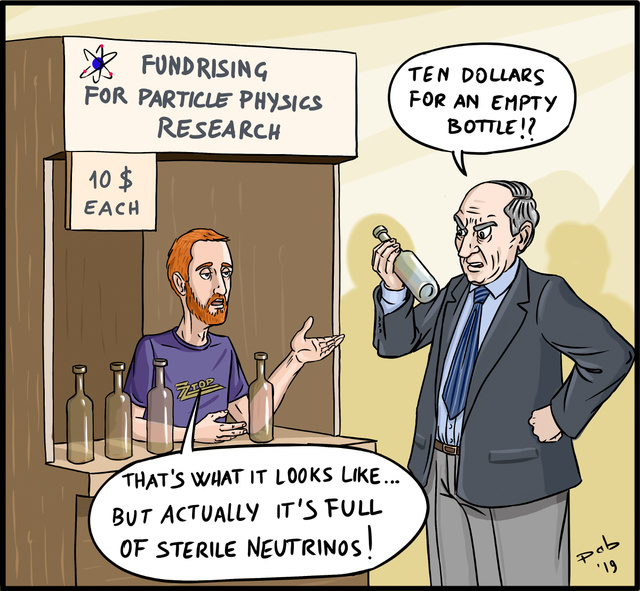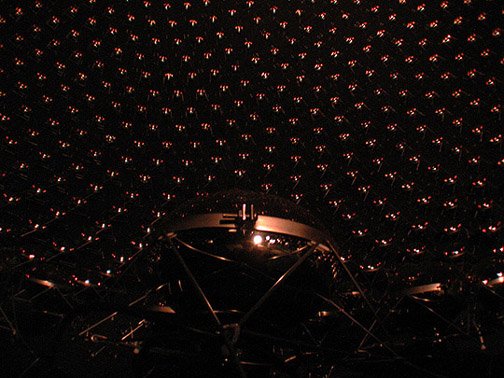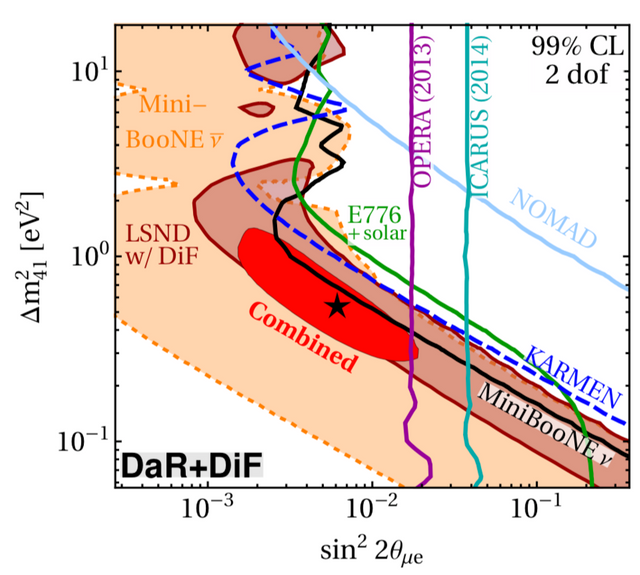Sterile neutrinos as a path to dark matter
The existence of three classes of neutrinos is confirmed today, which matches the predictions of the Standard Model of particle physics that also considers them massless. However, recent findings demonstrate that neutrinos are massive, so that they turn into each other when propagating.
Whereas these so-called neutrino oscillations are understood better and better, data recently revealed anomalies. One possible explanation features a fourth type of neutrino, called sterile neutrino.
In contrast with the three neutrinos of the Standard Model, sterile neutrinos only interact through gravity and via oscillations into the other ‘active’ neutrinos. More fascinatingly, such a sterile neutrino could viably be dark matter!

[image credits: @pab.ink]
Neutrinos in a nutshell

[image credits: NASA/SDO ]
Neutrinos were discovered 100 years ago when the mysteries of radioactivity were worked out.
A significant amount of energy was disappearing in the radioactive decay of unstable atomic nuclei, which challenged energy-momentum conservation (one the most solid laws of physics).
This missing energy was in fact carried away by an electronic neutrino, i.e. an invisible particle related to the electron.
In 2019, we know that there are three ‘flavours’ of neutrino respectively associated with electrons, muons and taus (muons and taus being heavier versions of the electron). Moreover, when they propagate, each neutrino can oscillate into another one.
Neutrino oscillations and their anomalies
As a consequence of its oscillating nature, a neutrino can be produced as of a given flavour A, and be observed, hundreds of kilometres away, as a neutrino of a different flavour.
This is called neutrino disappearance (we observe less neutrinos of type A than produced) and appearance (we observed flavours of neutrinos that were not initially produced).

[image credits: Fermilab]
All appearance and disappearance processes can be explained by fitting from data a handful of parameters.
In the 1990s, the LSND experiment studied the appearance of electronic neutrinos from muonic neutrinos and observed much more electronic neutrinos than expected.
As this seemed to contradict all other neutrino experiments (and the fits), MiniBooNE was designed to test the same signal with another technique.
The anomaly was confirmed in 2018, without totally excluding the standard neutrino oscillation mechanism.
Saved by sterile neutrinos?
The LSND and MiniBooNe anomalies can be explained by adding to the Standard Model a fourth, sterile, neutrino. This neutrino does not feel the weak interaction, in contrast to the other neutrinos, and can thus only appear through their oscillations.
A recent publication has shown (see the figure below) that if the sterile neutrino is much heavier than the other neutrinos (the y-axis) and mixes a little bit with them (the x-axis), it becomes possible to obtain a fairly good fit of neutrino data.

[image credits: arxiv]
In the meantime, the ICARUS and OPERA experiments further tested the sterile neutrino hypothesis, everything on the right of the purple and green lines being now excluded. We should however stay tuned as future improvements are expected.
Take-home message: the door to dark matter
We know today that there are three species of neutrinos that oscillate into each other. However, data exhibits some anomalies with respect to our understanding of neutrino physics. This may point to the existence of a fourth sterile neutrino that does not interact through weak interactions.
Whilst such a neutrino helps to get good fits of all neutrino data, it also consists in a particle extremely weakly interacting with the rest of the Standard Model (i.e. only via a feeble mixing with the active neutrinos and gravity). Could it be dark matter?
The short answer is yes: adding several sterile neutrinos to the Standard Model could allow the theory to be cosmologically favoured.
PS: This article has been formatted for the steemstem.io front-end. Please see here for a better reading.
SteemSTEM
SteemSTEM aims to make Steem a better place for Science, Technology, Engineering and Mathematics (STEM) and to build a science communication platform on the blockchain.
Make sure to follow SteemSTEM on steemstem.io, Steemit, Facebook, Twitter and Instagram. Please also consider supporting our witness (@stem.witness).
The thing about learning and plugging away is that little pieces start fitting together. When I read "neutrino" in your blog, I thought 'Fermi'. I remembered reading some time ago about radioactive decay. Neutrinos were in some way involved. Now I know how !! Aha.
And that neat law: energy-momentum conservation--put that together with the principle of symmetry. The order of the physical universe becomes more comprehensible.
The fourth neutrino, oscillating gently, invisibly--possibly holding the keys to (no, possibly being) dark matter. It's really quite beautiful and exciting.
Thank you!
Thanks a lot for passing by and leaving this nice comment!
That is fully correct. Pauli and Fermi indeed initiated what has paved the way to our understanding of the weak force. For more information, I refer to this post I wrote more than 3 years ago.
Funnily enough, energy conservation is a symmetry: the laws of physics are invariant under translations. :)
A fourth neutrino cannot help as it would be too light for being dark matter. But we can add as many sterile neutrinos as desired without impacting the visible part of the theory. With at least two sterile neutrinos, dark matter is there.
There are however other options for dark matter, and one must keep in mind that neutrino anomalies are called anomalies because some experiments disagree with others. This is why ICARUS is important to double check independently those things.
I'm so pleased the two concepts came together in my head. I think a rough sort of understanding is developing...thank you for the 'lessons' :)
I don't see that as 'lessons', really ;)
No, not lessons. But I learn...very relaxed and congenial, but still, learning. For me, every day, that makes life more interesting.
:)
thanks for the post! i had heard something about potential new physics and dark matter, but my google fu failed me and i was starting to think I had dreamt it or something
New physics (and dark matter that is part of it) consists in a good fraction of what I work on on an every day basis. We have anomalies here and there, but nothing is for now solid enough to exclude what we call the Standard Model. Hopefully, a stronger sign will come with more data :)
Out of all your posts this has been the clearest one for me!
I found it pretty self-explanatory. The overview about neutrinos in general at the beginning was a very smooth way to introduce us to sterile neutrinos. The transition to presenting neutrino oscillations and anomalies was quite curious for me, as I found the appearance and disappearance process quite peculiar :) Also, as we're talking about oscillation ... do neutrinos behave like matter and waves (?).
Finally, it was nice to read the take-home message and be reassured that what I had in mind up to then was the right message/notion to take away from the article :)
Thank you @lemouth for taking the time to digest and re-digest all this info for us, and make us aware of this fascinating "hidden" world!
Ps: The illustration is absolutely wonderful! <3
I wish you & the family a peaceful Wednesday evening!
Hi Abi!
Thanks for constantly passing by my posts week after week! I am happy that you managed to digest this one quite well, without any issue (and I am always there in case where a clarification would be needed).
This is because you are slowly becoming a particle physics expert ^^
All elementary particles are quantum and therefore behave both as a wave and a point-like object. And so do thus neutrinos. This is actually the case for any quantum system.
@pab.ink deserves the credits for the image that I like a lot. And believe it or not, the researcher looks actually like me!
Have a nice evening too!
Well ... 😎 I thank @lemouth, the @steemstem community .... 😝
Of course ^^
What would produce these sterile neutrinos? Remnants of the big bang, stars, black holes? If it is indeed dark matter and there is a lot of this in the universe, what are the theories for its formation? Can you explain a little bit about the neutrino oscillations? I'm also super confused by this figure
Are you saying the y axis is the difference in Mass and the x axis is the angle that they are being detected?
Also, I found this link that I think relates to the oscillations of neutrinos. I remember learning about eigenvalues and eigenvectors in college, but I suppose I never fully understood them
https://phys.org/news/2019-09-theorists-rosetta-stone-neutrino-physics.html
Whilst they are sterile and thus non interacting with anything, sterile neutrinos nevertheless mix a little with all other neutrinos. Since all other neutrinos are sensitive to the weak force, sterile neutrinos have hence a reduced sensitivity to the weak force through this mixing. This sensitivity is however super-suppressed because of the small size of the mixing.
Some sterile neutrinos could have been produced in the early universe, but also later on during the course of the universe history, through oscillations of non-sterile neutrinos.
Those oscillations means that when a neutrino propagates, there is a given probability that if it is of type A (A can be any type of neutrino), it will be detected as a neutrino of class B (again, B can be any type of neutrino). Emphasising with an explicit example: an electronic neutrino produced in a star could reach Earth as a muon, tau or even a sterile neutrino (assuming sterile neutrinos exist). Is that clearer?
Concerning the image, it shows the relations between the mixing pattern of the sterile neutrino with the electron and muon neutrinos (x-axis) and the mass difference between the sterile neutrino and the others (the y-axis). The coloured areas are the regions favoured by the anomalies, the red area being the most favoured one. The vertical lines (OPERA and ICARUS) are constraints: everything on their right is excluded. The other lines represent constraints from the non observation of anything by other experiments: everything on top is excluded. I hope this clarifies the whole story. Otherwise, feel free to come back to me!
If neutrinos have antimatter versions, would that mean there could be an antidark matter sterile neutrino?
This is a good (open) question and I can't answer it. Actually, no one can. Physicists are still investigating whether neutrinos are their own antiparticle (i.e. are neutrinos and antineutrinos the same object)? Hopefully, we will know more soon...
Concerning the studied dark matter models, in some of them the dark matter is its own antiparticle (anti dark matter equals dark matter) and in some other not. Both are very viable according to current data.
That makes it much more clear for me. Thank you for the detailed response
You are very welcome! :)
very likely behind on a few replies already but im just gonna push it on the stack ...
though google keeps telling me in lots of places the standard model isnt actually proven , CERN itself seems to have a more nuanced opinion
.it is not time for physicists to call it a day just yet. Even though the Standard Model is currently the best description there is of the subatomic world, it does not explain the complete picture. The theory incorporates only three out of the four fundamental forces, omitting gravity. There are also important questions that it does not answer, such as “What is dark matter?”, or “What happened to the antimatter after the big bang?”, “Why are there three generations of quarks and leptons with such a different mass scale?” and more. Last but not least is a particle called the Higgs boson, an essential component of the Standard Model.
A lot of why but that's the reasons theorists exist ofcourse (and i suppose CERN has every reason to defend the model, lol)
Same thing for the neutrinos although i do remember that bit on indirect detection which i think you wrote and cherenkov radiation (which i think i got from a bbc horizon or something) so as stated here and [here](For study, neutrinos can be created artificially with nuclear reactors and particle accelerators.) where it says you can actually artificially create them in an accelerator ?
It also says they do interact with gravity but 'not with the strong force' o wait heh ... okay ....
o yea it says 'weak sub-atomic force' AND 'gravity there, they interact with both of them, i assumed until now weak force is a synonym for gravity , so it's not ?
(that's a nasty billboard steemstem has there btw, like HUGE)
This is all in theory (because it's theoretical physics) but the numbers work out so can i , for the time being, consider the sterile neutrino the missing link that will plug 95% of the gaping hole the universe is at the moment ?

(ill get back to the other replies too but its weeks at the moment, i wish i could say i had no time lol, i just have no brain lately and time seems to be having me, not the other way around)
Thanks for this nice interesting comment. I enjoyed answering it! :)
The Standard Model is not entirely proven at all. I agree with the quote from the CERN website.
The entire Brout-Englert-Higgs mechanism that is responsible in particular for mass generation rely on a quantity that has not been measured so far, and that even after the end of the run of the Large Hadron Collider in a couple of decades will stay unmeasured. The interactions of the Higgs boson with the lighter particles are untested (and there is no way to test it for now). And so on.
Therefore, with this respect, the Standard Model is not complete. In addition, there is a bunch of conceptual limitations and issues that make us think that the Standard Model is not the end of the story (and this is why most of us impatiently wait to find what lies beyond it.
Yes, we can produce beams of neutrinos and detect them a few hundreds of kilometres away. This is one of the way to measure the appearance/disappearance effects I mentioned in the post. The production mechanism is quite "easy". The short version is as follows. We focus on a process in which we know neutrinos are produced, and manage to get rid of anything else from the beam once the process happended. One ends up with a beam of neutrinos :)
I admit this is slightly confusing. There is the weak force in the sense of the weak interactions. Active (i.e. non sterile) neutrinos feel it. Gravity is felt by every particle. However, the strength of gravity is even weaker than the strength of the weak force. Does tu clarify?
Unfortunately not. Sterile neutrinos fit the data well. But the fit without sterile neutrinos is not catastrophic, on the other hand, so that it is impossible to conclude at the time being.
I once read somewhere that neutrinos are fermions. Can't remember where though. If they are fermions, does it mean that neutrinos follow the DIRAC statistics? I think you once talked about DIRAC sometimes ago, if I'm not mistaking.
Hope I'm not asking a stupid question?
Nice post sir
PS: The first image got me laughing :D
The first images has been designed by @pab.ink. Please do not hesitate to congratulate him (he is on discord).
This is totally correct!
Neutrinos can be either Dirac fermions or Majorana fermions. This we do not know yet (please see my other comment above where I discuss this topic). The only difference between a Dirac and a Majorana fermion is that a Majorana fermion is its own antiparticle.
PS: there is no stupid question. Only stupid answers :)
How interesting, we might be at the doorstep of a major discovery. It would be awesome if you might add some possible applications that such discovery might have...
The way science seems to work is major breakthroughs in understanding could have unknown applications in the future. For example, time dilation as predicted by Einstein has lead our GPS devices to more precisely know our location. It is hard to say how knowing what applications could come from having a better understanding of dark matter. The discoveries today could lead to something huge years down the road. Maybe it is the key to help us avoid an asteroid collision or a new method for harnessing energy.
I got it, what I wanted to see in the post (as a constructive criticism, I already liked it very much as it is) is some stress in the current application that neutrinos have in mother physics... For instance how we manage to keep nuclear reactors working steadily by knowing the profile of the particles generated, and what challenges can be worked out through further comprehension of this particles.
I have tried to answer above, please let me know if this satisfies you. Probably not but I am afraid I can't say anything else.
To go back to the very specific example you mentioned: Weak interactions are everywhere, especially in nuclear physics. However, the physics behind it is known for a very long time. Understanding the fine details of neutrino physics won't help the reactors working better. Actually, it is even somehow the opposite: we use certain reactors as neutrino factories from where one can measure what is going on to refine the theoretical modelling.
I just read your reply and first I want to show my gratitude for taking your time to explain me things a bit further... I get that a theory is a model of reality that allow us to predict what will happen if certain conditions met. Therefore the ability to predict what will happen to subatomic particles when they interact with any of the fundamental forces surely will enhance our ability to understand better the phenomena occuring in the atomic nuclei... What will come out of it? It seems like we can only take a guess 😜
It is always a pleasure to me to answer comments and give further explanation. That is to me the main point in blogging on science ;)
The idea is to try to understand better how the universe works. The rest is beyond our control and we will indeed have to see in 100 years what humans will make out of that knowledge. However, in the process, we may gain a little ;)
The short answer is: there is no application... for now. As @theabsolute said it, this concerns fundamental research: we are trying to understand how the universe works, and this has no direct application. However, the theories that are being developed may play a crucial role in the future. I like the GPS example. In 1917, general relativity was a theoretical curiosity. Today, 100 years later, it is a well established theory that allows, for instance, GPS to work as expected.
This being said, one should not underestimate the outcome of fundamental research: we are trying dozens of students to solve complicated problems during 3-6 years (the usual timescale of a PhD thesis). This skill is well demanded in the private sector. In addition, we are building un-patented technologies for our experiments, so that everyone on Earth can use them for free (imagine a world where everyone will have to pay one cent to CERN for every click on the Internet ;) ). And so on.
Would be interested to know if this new class of particle is affected by the Higgs Field? Very interesting post, thanks.
Yes it is.
The interactions of the sterile neutrinos with the Higgs boson contribute to their mixing and their mass. However, in most neutrino mass models (there is no neutrino mass in the Standard Model and they are needed by virtue of neutrino data), the Higgs sector has to be more complicated. In particular, several Higgs bosons are in order.
This post has been voted on by the SteemSTEM curation team and voting trail. It is elligible for support from @curie and @minnowbooster.
If you appreciate the work we are doing, then consider supporting our witness @stem.witness. Additional witness support to the curie witness would be appreciated as well.
For additional information please join us on the SteemSTEM discord and to get to know the rest of the community!
Thanks for having used the steemstem.io app. This granted you a stronger support from SteemSTEM. Note that including @steemstem in the list of beneficiaries of this post could have yielded an even more important support.
Hello steemstem!
Congratulations! This post has been randomly Resteemed! For a chance to get more of your content resteemed join the Steem Engine Team
Info acquired...
Great! :)